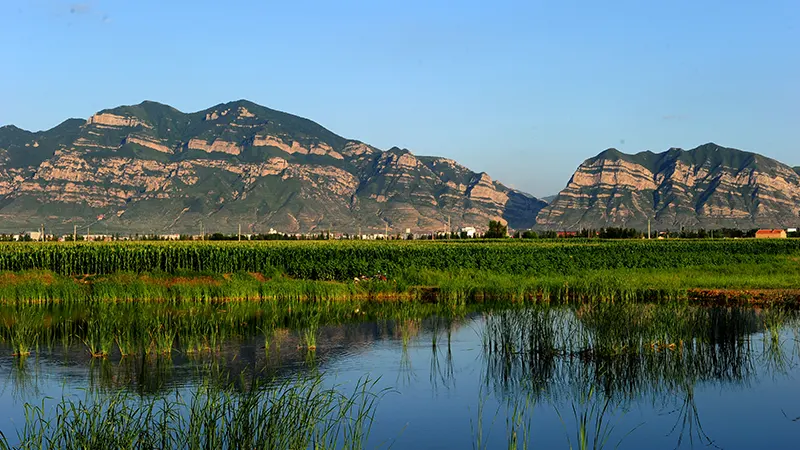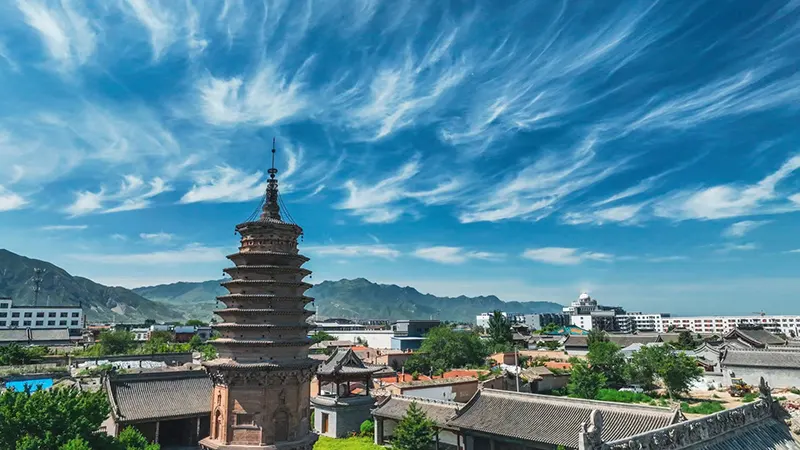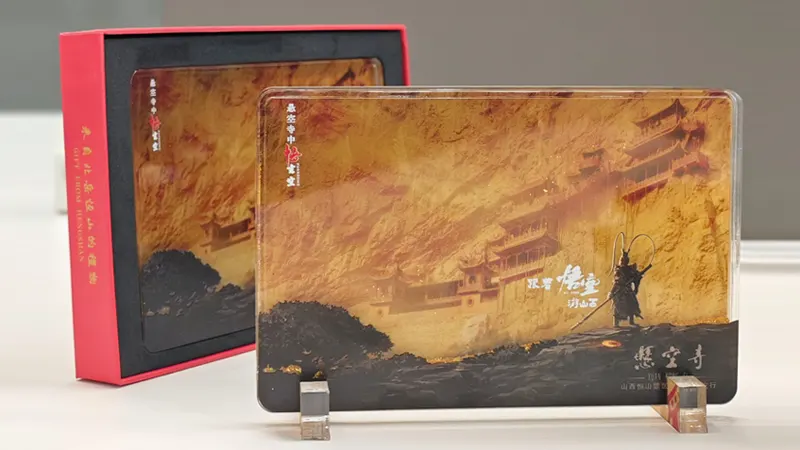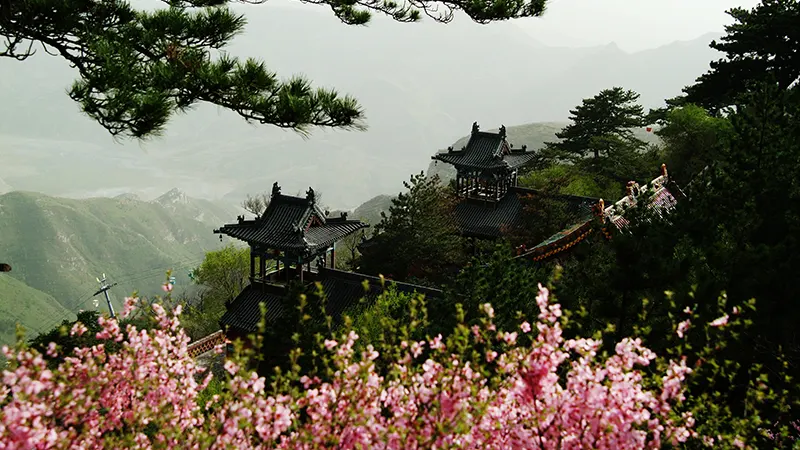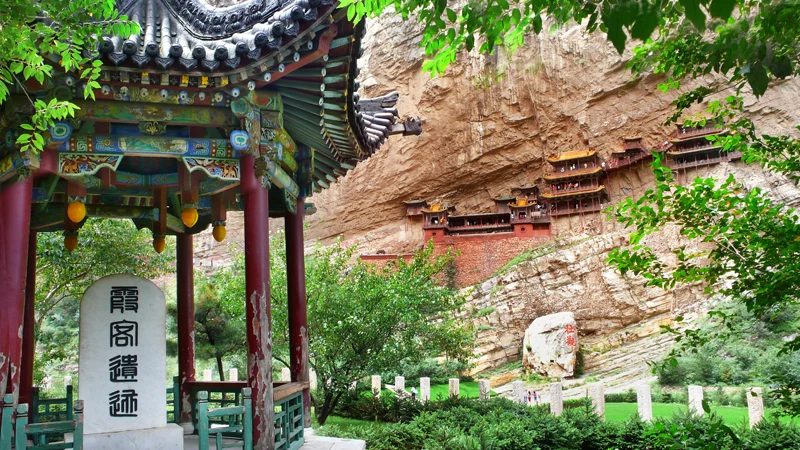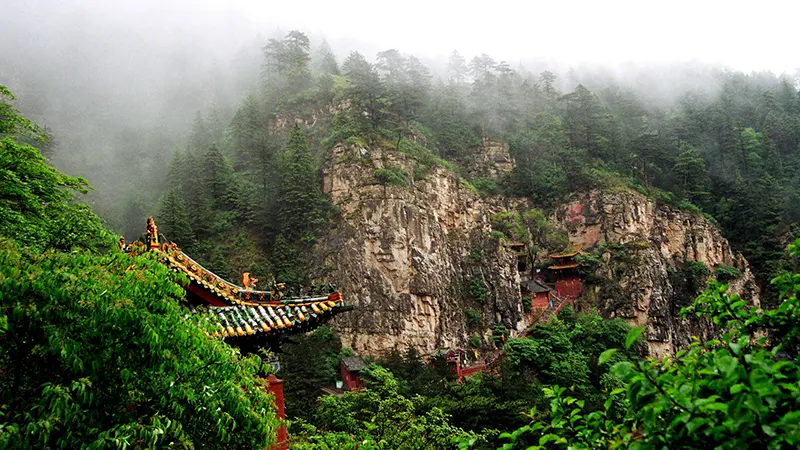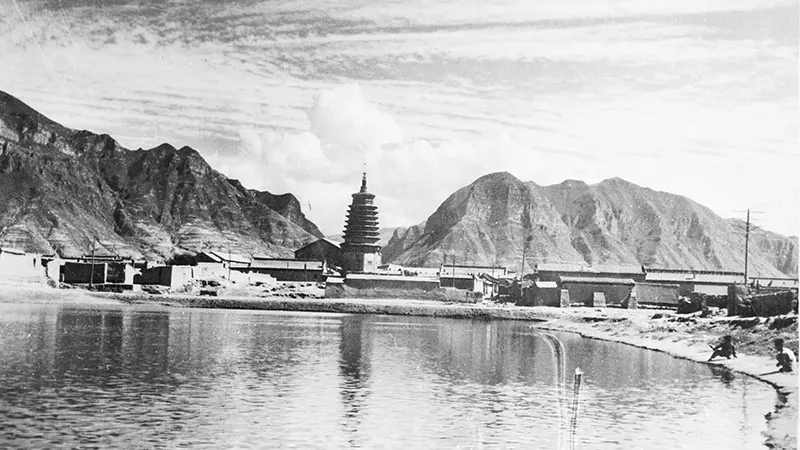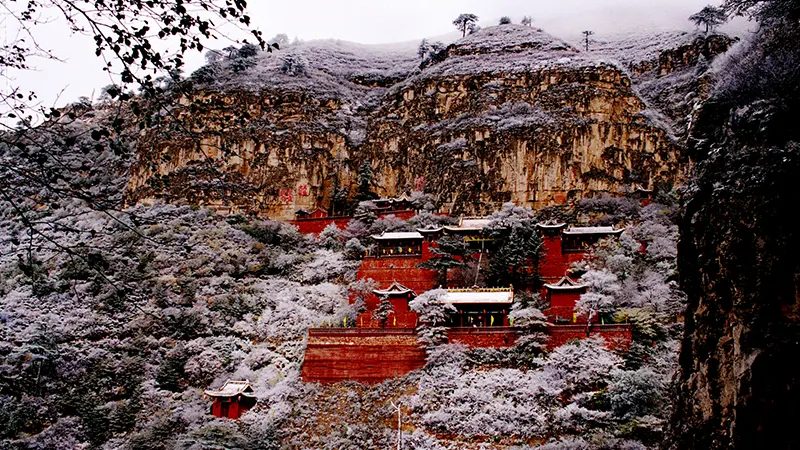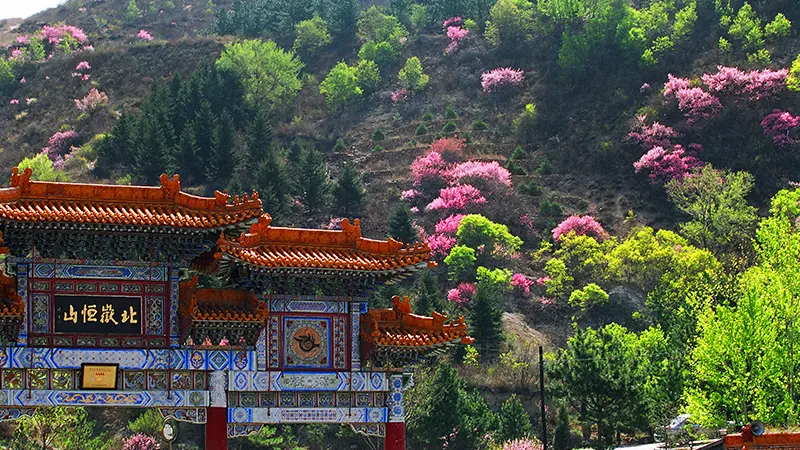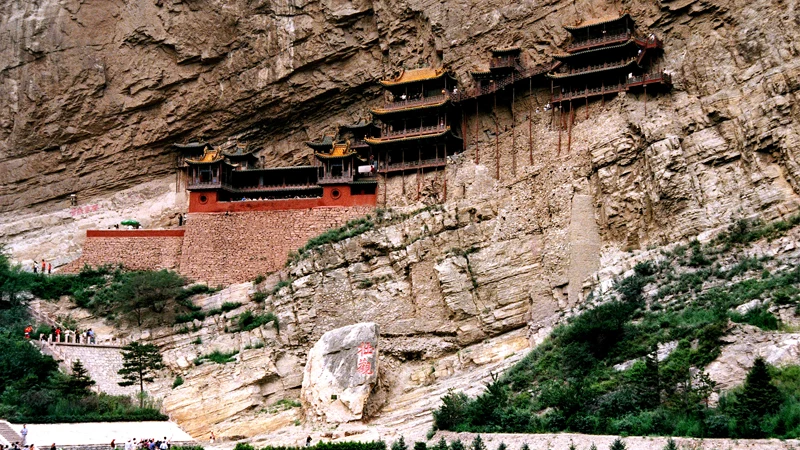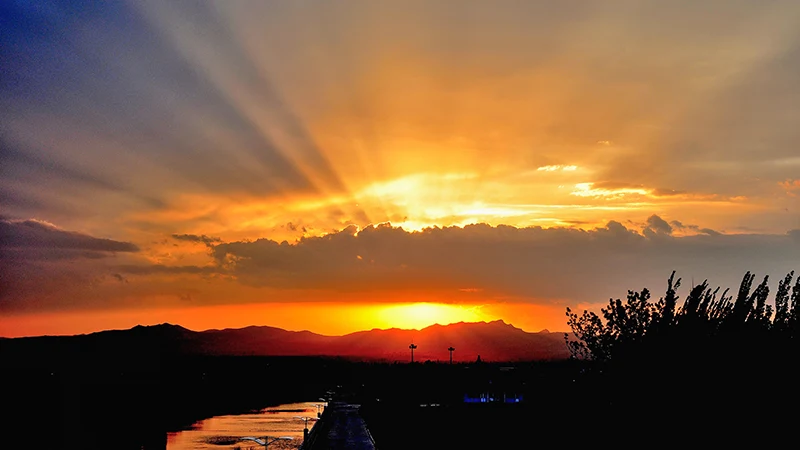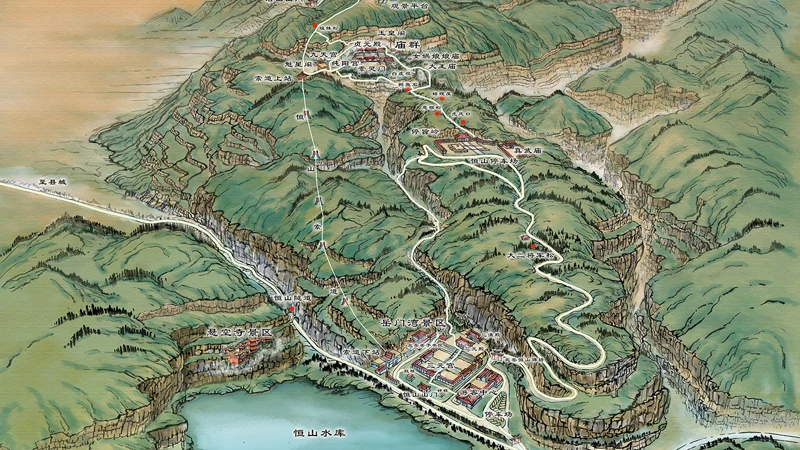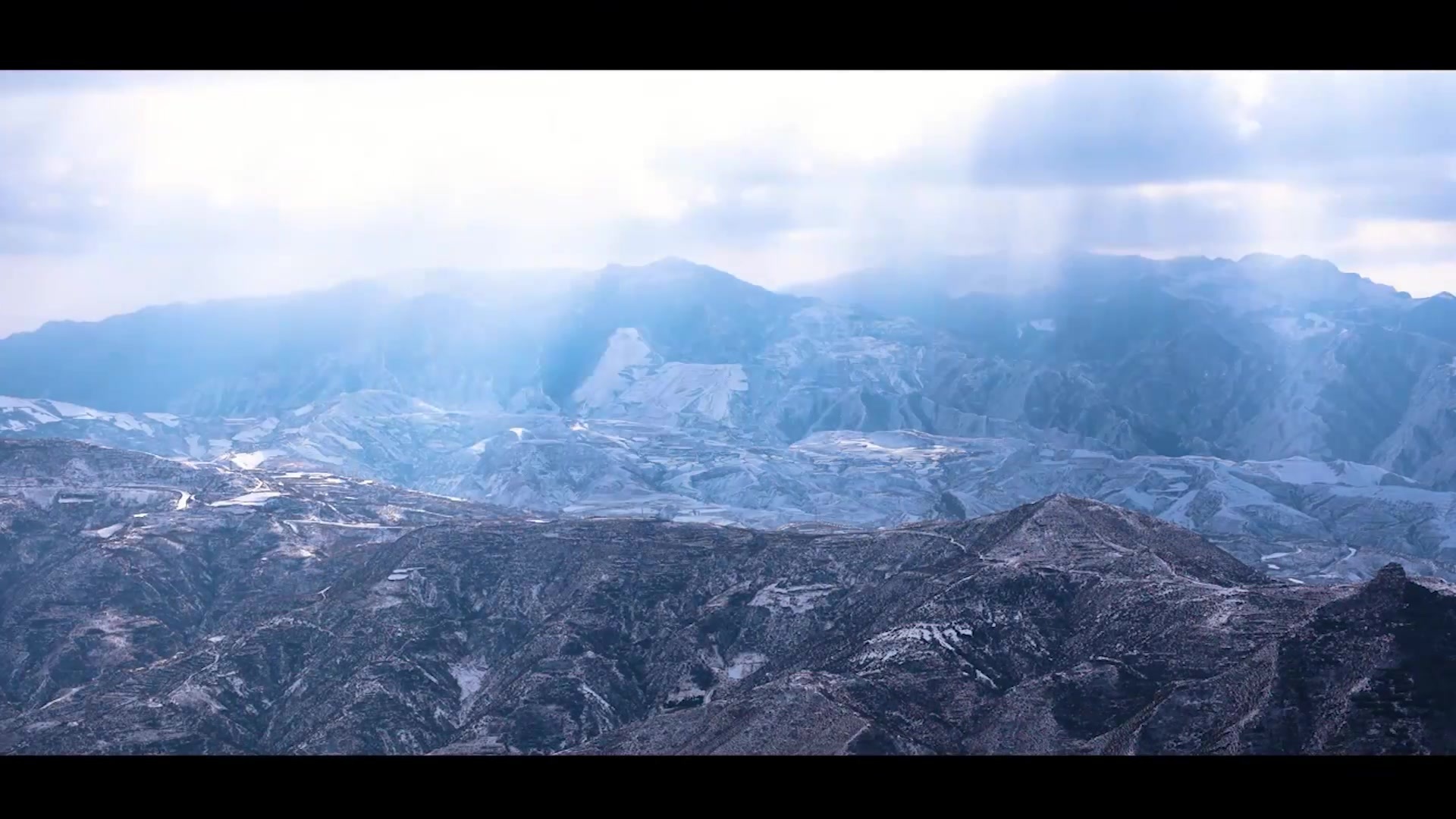Ancient Celebrities and Hanging Temple
Publish Time:
2025-03-14 15:37
Source:
The Hanging Temple, a renowned ancient Chinese structure built during the Northern Wei Dynasty, is breathtaking in its unique cultural heritage and exquisite architectural artistry.
The Hanging Temple, a renowned ancient Chinese structure built during the Northern Wei Dynasty, boasts a unique cultural heritage and exquisite architectural artistry that leaves people awestruck.
The renowned Chinese sociologist, Mr. Fei Xiaotong, proposed the concept: "Each is beautiful in its own way, appreciating the beauty of others, achieving harmony and beauty together, leading to universal harmony." Su Shi of the Northern Song Dynasty also stated in his poem "Inscription on the Western Forest Wall": "Viewed from the side, it's a ridge; viewed from the front, it's a peak; from afar and near, high and low, it differs in every way." There are varying perspectives on the beauty of the Hanging Temple, both ancient and modern. For instance, the contemporary renowned poet, Ben Shui, described the Hanging Temple he saw as: "A temple hanging on a cliff face; what's the difference between this and a basket hanging on a wall? Bodhisattva, return to the temple, like a mud-caked sweet potato in a basket." What simple beauty, like a basket of sweet potatoes hanging on a cliff face. In ancient times, several notable figures visited the temple and left behind their impressions for posterity; these are the famous "Three Views" of the Hanging Temple.
I. A Marvelous Sight
Ming Dynasty - Chen Fei
One day, around the 35th year of the Jiajing era in the Ming Dynasty, a group of people arrived at the Jinlong Gorge of Hengshan Mountain. Among them, a centrally positioned official, dressed in formal attire and riding a tall horse, was escorted by numerous local officials and soldiers deep into the Jinlong Gorge. After rounding several bends, a group of three-story vermilion buildings, supported by 90 vertical pillars of varying lengths, suddenly appeared on the cliff face in the distance. The precarious nature of the structure caused him to exclaim in admiration. This group of buildings hanging on the east cliff of Cui Ping Peak in Hengshan Mountain is the Hanging Temple. After visiting the Hanging Temple, at the enthusiastic invitation of everyone present, he passionately wielded his brush and wrote three large characters. One of these is the two vermilion-colored regular script characters "奇观 (Marvelous Sight)" that are now engraved on the west cliff of Ciyao Kou, near the Xuanwu Lake dam, on the cliff of Cui Ping Peak. This Ming Dynasty official was Chen Fei, then the deputy superintendent of Shanxi Province and later the governor of Gansu Province.
According to the "Biographical Dictionary of Chinese Celebrities Through the Ages": Chen Fei, Ming Dynasty, from Yanling County, Henan Province, styled Ru Zhong, alias Wen Gang, also said to be styled Wen Gang. A Jinshi scholar in the 14th year of the Jiajing reign. Served as a censor of the Ministry of Rites, known for his outspokenness and fearlessness in addressing powerful figures. Because of his outspokenness, he was demoted to the post of county magistrate in Changyuan, then promoted to the post of county magistrate, his governance was mild and fair, winning the respect of officials and the people. He rose to become governor of Ningxia and a Grand Censor. He authored the "Collected Works of Chen Wengang." According to Baidu information: Chen Fei (1505-1559), styled Ru Zhong, alias Wen Gang, from Yanling County, Kaifeng Prefecture, Henan Province; a craftsman by profession, a student at the Imperial College, specializing in the "Book of Rites"; in the ninth year of the Jiajing reign (1530), he was the 43rd-ranked successful candidate in the Henan provincial examinations; in the 14th year, the 82nd-ranked successful candidate in the metropolitan examinations; appointed a scribe; in the 21st year, he served as a censor of the Ministry of Rites; in the 23rd year, promoted to the rank of Right Censor; in the 24th year, he submitted a memorial to remove the false deities and correct the ancestral rites, clarifying the distinction between China and other countries and abolishing the sacrifices to Kublai Khan; promoted to the rank of Left Censor of the Ministry of Revenue; outspoken and fearless, he did not shy away from powerful figures; due to his outspokenness, he was demoted in the 26th year to the post of county magistrate in Changyuan County, Grand Name Prefecture; he served as county magistrate of Ningjin and prefect of Zizhou; summoned back to court, he was appointed to the post of an official in the Ministry of Punishment; promoted to the post of a senior official in the Ministry of Punishment; in the 28th year, he was appointed to the post of censor in Shaanxi; served as deputy superintendent of Shanxi and censor of Shaanxi; in the 36th year, he was promoted to the rank of Deputy Grand Censor, governor of Gansu; in the 38th year (1559), due to illness, he retired from office and died at the end of September. He authored the "Collected Works of Wen Gang" in twenty volumes, "An Explanation of the Eight Formations" in two volumes, and "An Examination of the Fire Train Formation" in one volume.
Chen Fei had outstanding achievements and gained the trust of the emperor and the praise of the people during his tenure. During his time as Right Censor of the Ministry of Rites, his memorial "To Remove the False Deities and Correct the Ancestral Rites" received the imperial endorsement: "The words of the Censor Fei are as if instructed by a divine being." This shows the emperor's recognition of him. After his demotion to Changyuan County, the emperor, at eleven o'clock at night on the sixteenth day of the second month, spontaneously thought of this competent and upright official who was demoted, specifically inquired about Chen Fei's situation with the Ministry of Personnel, and gradually promoted him. Volume 20 of "Collected Works of Mr. Chen Wengang" states: "In the 30th year of Jiajing's reign, the emperor, in the fifth year of the term, dispatched officials from the Ministry of Justice to examine the cases in the world, and at this time he used this to show sympathy. So Chen Fei received the order from Shaanxi; he revered the emperor's virtue, and in all things was respectful and cautious. Then he entered Tongguan in early autumn, traveled through eight prefectures and three counties, and found almost three hundred cases of capital punishment; he petitioned the court for 150 people; for the rest, he ordered the officials to investigate and reduce the punishments, so that nearly 10,000 people were reduced in punishment, from exile to flogging." Chen Fei was mild and lenient in his administration and showed particular consideration to the common people. During his tenure in Shaanxi, he treated the people's punishments with careful scrutiny, adhering to leniency, so that the people of Shaanxi suffered less from harsh punishments and gained their recognition. Later, to quell the unrest in Shaanxi, the emperor specifically appointed Chen Fei as the censor of Shaanxi, which shows his outstanding achievements.
Ancient officials were mostly Jinshi scholars, therefore proficient in poetry, calligraphy, and painting. Chen Fei, a Jinshi scholar, was exceptionally talented, well-versed in classics and history, possessing deep cultural knowledge and not inferior to his colleagues; his calligraphy and literary talent were unparalleled. In his spare time amid his busy official duties, he always found time to write poems and compose works. Every place he visited would have his memorable poems and writings left behind. Many of his frontier poems have been preserved, and are highly praised in the literary world, earning him the title of famous frontier poet. For example, one of his frontier poems from the "Collected Works of Wen Gang," "The Qilian Mountains," reads: "Gazing at Qilian from horseback, the peaks pierce the sky. To the west, it connects to Jiayu Pass; pure white, without a trace of smoke. Opposite peaks embrace Heli; the distant sea overlooks Juyan. Snow accumulates in all four seasons, bright and cold, even in June. Glad to see the hot and cold snow melt, it gently irrigates the fields. It can take the place of rain and dew, it can be used to support the streams. Three Arrows General shooting, fame spread across the world. Who is the archer? Can they be compared across thousands of years?" This short frontier poem, "Qilian Mountains," uses different time and observation angles to vividly depict the vast and magnificent Qilian Mountains, while also expressing the poet's concern for the livelihood of the people and his ambition to make contributions, making it a classic among numerous poems praising the Qilian Mountains.
Chen Fei's calligraphy skills were also quite remarkable, and he left many inscriptions wherever he went throughout his life. According to Jinci research materials: Chen Fei was intelligent, knowledgeable in classics and history, skilled in poetry and calligraphy, especially cursive script. In 1549, Chen Fei visited Jinci Temple, and inspired by the scenery, he inscribed a poem on the stone, titled "Viewing the Three Spirit Pools of Jinci Temple". The following summer, Chen Fei visited Jinci Temple again and inscribed another poem on the stone, titled "Thirsty Tang Hou Temple". The calligraphy of the two poems has been preserved and is of extremely high value. "Jinci Records · Biography of Chen Ji Jian" states: "His poems and cursive script are vigorous and powerful, like dragons and snakes flying in the sky, running and soaring, with an unstoppable momentum." It also says "It has the style of Zhang Xu and Mi Yuanzhang." Chen Fei left three inscriptions at the Hanging Temple in Hengshan Mountain. According to Chen Fei's resume, he should have come to Hunyuan for inspection during his tenure as the deputy envoy of Shanxi Provincial Education, approximately between 1554 and 1557, which is also the time frame for the inscription of "Marvelous View". Of course, general inscriptions are usually in regular script to show solemnity. It can be seen that when this official, who was skilled in cursive script, wrote this regular script, he was preparing to inscribe it on stone. For such a famous official whose footprints covered Jin, Ji, Shaanxi, and Gansu, and a master of calligraphy and poetry, after traveling through so many scenic spots, he was able to write the comment "Marvelous View" at the Hanging Temple, which shows the strong shock the Hanging Temple, one of the most dangerous buildings in the world, gave him.

▲Marvelous View Hanging Temple Stone Inscription
II. A Great Sight of the World
Ming Dynasty · Xu Xiake
About seventy years after Chen Fei's visit to the Hanging Temple, another illustrious figure arrived at the Hanging Temple. He was also shocked by the Hanging Temple and excitedly wrote the praise "A Great Sight of the World" in his travelogue. This inscription now stands by the river not far from the Hanging Temple. This famous person is the great traveler Xu Xiake.
Xu Xiake (1586-1641), whose given name was Hongzu and courtesy name was Zhenzhi, was also known as Xiakke. He was a geographer, traveler, and writer from Jiangyin (present-day Jiangyin City, Jiangsu Province) in the Ming Dynasty. He was the author of the famous geographical work "Xu Xiake's Travel Notes." He began traveling at the age of twelve. In more than thirty years, he "crossed the East China Sea to Putuo Mountain, traveled north to Yan and Ji, south to Fujian and Guangdong, climbed to the peak of Mount Hua in the northwest, and went as far as the border of Yunnan and Guizhou in the southwest, his footprints covering fourteen provinces at that time." He turned 30 years of travel into writing, compiling "Xu Xiake's Travel Notes," totaling more than 2.6 million words (of which 2 million words were lost, and now only more than 600,000 words remain). He dedicated his life to travel and exploration, and it is well-deserved to call him the "Sage of Travel" and "A Unique Person in History."
In early July 1633 (the sixth year of Chongzhen), 47-year-old Xu Xiake set off from Zhongdu, passed through Fuping in Zhili, entered Shanxi, and began his journey to Mount Wutai and Mount Heng. His visit to Mount Heng in the sixth year of Chongzhen (1633) was 27 years earlier than the relocation of the Northern Mountain to Hunyuan in the seventeenth year of Shunzhi (1660). A few days later, Xu Xiake wrote "Diary of a Trip to Mount Wutai" and "Diary of a Trip to Mount Heng," fulfilling his promise to his friend Xie Depu. Xie Depu, a lecturer at the Imperial College, a writer of the late Ming and early Qing dynasties, and a Jinshi, once gave Xu Xiake a poem: "Now I am going to Mount Heng again, it is like looking at the white clouds from Qingke." These two travelogues were later included in "Xu Xiake's Travel Notes" and became classics of Chinese travel essays.
Since 2011, the State Council has designated May 19 as "China Tourism Day," which originates from the opening day of the first entry in "Xu Xiake's Travel Notes." Xu Xiake had a great mother who particularly supported her son's travels. She told her son: "Ambition lies in all directions, it is the business of a man." She also specially made a travel hat for Xu Xiake. When she was over seventy years old, she still traveled with Xu Xiake. In the past, there was Meng's mother moving three times, and Xu Xiake's mother was undoubtedly the Meng's mother of the Ming Dynasty. In "Xu Xiake's Travel Notes," he exclaimed that the Hanging Temple was "A Great Sight of the World," which was very good publicity and marketing for Hunyuan.
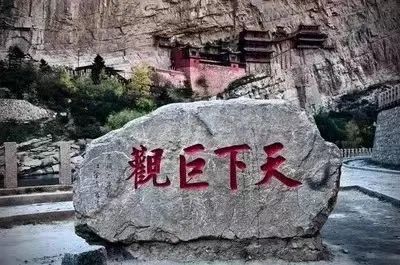
▲A Great Sight of the World Hanging Temple Stone Inscription
III. Magnificent
Tang Dynasty · Li Bai
An earlier "three views" celebrity than Chen Fei and Xu Xiake is Li Bai, the "Immortal of Poetry" of the Tang Dynasty. He inscribed the calligraphy praise "Magnificent" at the Hanging Temple, and now this inscription of "Magnificent" has become a popular check-in spot for tourists.
According to relevant records, Li Bai, who "searched for immortals in the Five Great Mountains without hesitation, and loved to visit famous mountains all his life," visited Mount Heng at least twice. Li Bai loved to travel with his sword throughout his life. From the age of 15, he wandered around the country, traveling throughout the south and north of China, leaving behind many beautiful and popular poems wherever he went. His first visit to Shanxi was in May 735 (the twenty-third year of Kaiyuan). Li Bai was invited by his friend Yuan Yan to travel through the Taihang Mountains to Shanxi. Yuan Yan, a talented man of letters, was relatively wealthy. At that time, Yuan Yan's father was the prefect of Taiyuan, responsible for defending the northern border. Li Bai and Yuan Canjun (Yuan Yan) had several interactions, and the two were congenial and cherished each other, and could be called bosom friends. Yuan Yan once built a building by the Tianjin Bridge in Luoyang for Li Bai's exclusive use. Li Bai once wrote a poem recalling the two people's interactions, "Recalling the Past and Sending to Yuan Canjun of Qiao County," which includes these lines: "In May, we called each other to cross the Taihang Mountains, and the wheels were broken, not knowing the hardship of the sheep intestines. Coming to Beiliang, the years are deep, I appreciate your precious righteousness, lighter than gold. The jade cups, brocade food, and green jade cases made me drunk and full, with no intention of returning home. From time to time, I go to the west of the city, and the Jinci stream flows like jade." This fully expresses the preciousness of friendship and the praise of the beautiful mountains and rivers of Shanxi. The following spring, Li Bai, "missing home like the Fen River," longed to return home and left Shanxi to return to Anlu, Hubei.
More than a decade later, he came to Shanxi for a second time. Around the spring of Tianbao eleven years (752 AD), Li Bai traveled from Yixian County in Hebei, crossed Yimaling, arrived in Shanxi, passed through Hunyuan Jinlong Gorge, crossed Shui Che Valley, and reached the Hanging Temple. This time, his mood for touring Hengshan Mountain and the Hanging Temple was quite different from the last time due to the influence of villains in the court, the decline of the dynasty, the impoverishment of the people, and the instability of the border. While touring the Hanging Temple and Hengshan Mountain, his mood was probably gloomy, which is reflected in several of his "Ancient Style" poems written on Hengshan Mountain. As his poems express, "The Jin wind has already declined, and I cry at the end of the road", "Sparrows nest in the parasol tree, mandarin ducks roost on thorny bushes. Let us return, my sword song is a sorrowful road," etc. This was Li Bai's last visit to Hengshan Mountain. After visiting Hengshan Mountain, Li Bai stayed overnight at the Hanging Temple. Looking down at the rushing water in the valley and up at the stars, and touching the iron and wooden railings of the ancient temple built by the order of Emperor Daowu of Northern Wei, he was inspired to spontaneously recite the famous "Night Stay in a Mountain Temple": "A precarious building, a hundred feet high, I can pick the stars with my hand. I dare not speak loudly, fearing I might startle the people in heaven." This poem vividly displays the uniqueness of the Hanging Temple and leaves behind valuable historical and cultural heritage for it. After reciting the poem, he wrote the two characters "magnificent" in the temple, adding a dot above them to express his admiration for this aerial pavilion. There used to be a Tai Bai Shrine below the temple, with a statue of Tai Bai, but it has since been destroyed. The people of Hunyuan should thank this exiled immortal. A seemingly simple inscription and poem allows modern people from all directions to touch the profound essence of excellent traditional Chinese culture beneath the Hanging Temple, through the mists of a thousand years of history.
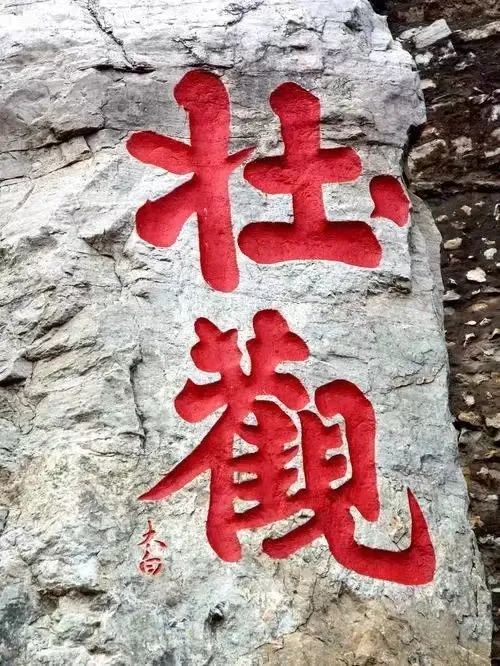

▲Magnificent Hanging Temple Stone Carving
"Wonder," "Magnificent," "Great Wonder of the World"—these are the "three wonders" of the Hanging Temple given by three outstanding ancient celebrities. The beauty of the Hanging Temple is actually inexpressible with words. I recall Lü Dongbin's poem of enlightenment after meeting Huanglong Chan Shi: "Abandoning my gourd and smashing my lute, from now on I will not cling to mercury gold. Since seeing Huanglong, I finally realize I had wrong my heart in the past." I feel it should be changed to: "Since seeing the Hanging Temple, I finally realize I had wrong my heart in the past."
Friends, if you want to accurately describe the beauty of the Hanging Temple, there is no other way but to "visit the Hanging Temple" yourself and write your own "wonder" of the Hanging Temple.
Proofreading: Xuefang
Editor: Xuelin
Author's Introduction
Yang Xinru, a native of Hunyuan, Shanxi, is a member of the Shanxi Writers Association.
Keywords:
Previous Page
Next Page
Related News
Republic of China hemp mat treasure | Guiyou (1933) Deng Hengyue Ji (with poems and texts)
In today's ancient city of Hunyuan, when discussing well-preserved ancient residences, one must mention the "Ma Family Courtyard." The original owner, Ma Xi Zhen, has also gained attention, as if the person is known because of their residence.
Republican High Liangzuo | 1935 North Shanxi Field Trip Notes
In the spring of 1935, the Nationalist Government in Nanjing dispatched Shao Yuanchong, a member of the Central Executive Committee of the Kuomintang, and Zhang Ji, a member of the Central Supervisory Committee, to Shaanxi to pay homage to the Yellow Emperor's Mausoleum. After the ceremony, Shao Yuanchong went on an inspection tour of Northwest China, visiting Gansu, Qinghai, Ningxia, Inner Mongolia, and Shanxi. His secretary, Gao Liangzuo, accompanied him throughout the journey, recording their observations and experiences, which were subsequently published in major newspapers and generated significant public attention.
Republic of China, Jiang Weiqiao | 1918 Hengshan Mountain photo album
In September 1918, Jiang Weiqiao, a councillor of the Ministry of Education of the Beiyang Government, was ordered by the Ministry of Education to inspect the academic affairs in Shanxi Province. He took the opportunity to pay his respects at Mount Wutai and Hengshan Mountain. He departed from Beijing on September 21, first taking a train to Shijiazhuang, and then to Taiyuan; then he took a carriage to Mount Wutai and Hengshan Mountain; and finally returned to Beijing from Datong by train on October 13.
Shao Yuanchong of the Republic of China | Brief Record of the 1935 Northern Mount Taihe Expedition
In the spring of 1935, the Nanjing Nationalist Government dispatched Shao Yuanchong, a member of the Central Executive Committee of the Kuomintang, and Zhang Ji, a member of the Central Supervisory Committee, to Shaanxi to pay homage to the Yellow Emperor's Mausoleum. After the ceremony, Shao Yuanchong went on an inspection tour of Northwest China, departing from Xi'an on April 25 and subsequently visiting Gansu, Qinghai, Ningxia, Inner Mongolia, and Shanxi.
Chen Xingya's Travelogue of Yungang Grottoes and Hengshan Mountain in 1935, Republic of China
Between the September 18th Incident and the Marco Polo Bridge Incident, Chen Xingya held the idle post of council member of the Peiping Pacification Commission, staying at home and often traveling with friends to various famous scenic spots in China.


